Instructions for authors: https://www.sbpmat.org.br/17encontro/authors/
Category: News
Director and former president of B-MRS are chosen as coordinators of the areas of Materials and Astronomy/Physics at CAPES.
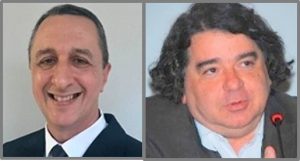
Two participating B-MRS members are listed among the new area coordinators (mandate 2018-2022) of CAPES, the Brazilian federal agency for the improvement of higher education, mainly graduate programs.
Professor Antonio Eduardo Martinelli (Department of Materials Engineering of the Federal University of Rio Grande do Norte, UFRN) was reappointed as coordinator of the Materials Area of CAPES. Currently, Martinelli is a B-MRS Scientific Director and chairman of the XVII B-MRS Meeting. He was also director of the society in 2008-2009 and 2016-2017.
Professor Fernando Lázaro Freire Jr (Department of Physics of the Pontifical Catholic University of Rio de Janeiro, PUC-Rio) was chosen coordinator of the Area of Astronomy/Physics of CAPES. Member of the founding board of B-MRS, Freire Jr, served two terms as president of the society (2006-2007 and 2008-2009) and two as director (2004-2005 and 2012-2013). He coordinated the Physics and Astronomy Area of the Rio de Janeiro State Research Foundation (FAPERJ) from 2008 to 2012. He was director of the Brazilian Center for Research in Physics (CBPF) from 2011 to 2015 and director of the Department of Physics of PUC-Rio from 2003 to 2008.
According to CAPES, the area coordinators are consultants designated to coordinate, plan and execute the activities of their areas, including those related to the evaluation of graduate programs. The process of choosing the coordinators involves all the Brazilian graduate programs of the area in question, as well as the boards and authorities of CAPES.
B-MRS Newsletter. Year 5, issue 3.
|
|||||||||||||||||||||||||||||||||||||||||
|
|||||||||||||||||||||||||||||||||||||||||
|
History of Materials Research: 30 years of LIEC – UFSCar.
The Interdisciplinary Laboratory of Electrochemistry and Ceramics (LIEC) of the Federal University of São Carlos (UFSCar) is completing 30 years of scientific research, development of innovative products and processes, training of scientists and extension activities.
The idea of creating an interdisciplinary laboratory emerged in 1988, from discussions of three research professors, two from UFSCar and the third from UNESP – Araraquara, with education background in chemistry, physics and physical chemistry. These professors were Elson Longo da Silva, Luís Otávio de Sousa Bulhões and José Arana Varela (deceased in 2016). “The idea came about because we had obtained equipment from funding agencies, but there was not enough space in our respective departments to allocate them,” recounted Elson Longo, now professor emeritus of UFSCar, during the commemoration of the anniversary of LIEC, on March 23.
The idea was materialized thanks to a partnership with Companhia Brasileira de Metais e Metalurgia (CBMM) to finance the construction of the building that would house the equipment. The company, Longo said, was interested in the future laboratory developing some products. “Fortunately, we secured their support for the construction of the building at UFSCar,” explained Longo
Soon after, the laboratory began to receive students interested in participating in the research. The first ones, recalls Longo, were Edson Roberto Leite (now professor at UFSCar), Carlos Alberto Paskocimas (currently at UFRN) Ernesto Chaves Pereira (UFSCar) and Maria Aparecida Zaghete (UNESP). “It can be said that over the past 30 years there have been hundreds of students who have completed their studies at LIEC,” said Longo. In addition to students from various UFSCar courses, LIEC has received young people from other institutions in Brazil and abroad for classes, courses and research at all levels of education.
Partnerships with the industrial sector have marked the history of LIEC in the following years. “The various research themes have been developed, and also changing, from theoretical reflections and from contacts with various companies,” declares Longo. “I emphasize that it was not the production of reflexive knowledge of business needs; on the contrary, such needs have given rise to new interpretive models and dialogues with other theories,” he clarifies.
One of the longest-standing industrial partners is Companhia Siderúrgica Nacional (CSN), with which the laboratory continues to work. Initially, LIEC helped the company eliminate the corrosion that the ceramic burner experienced. “The solution to this problem put the team to research and solve problems related to blast furnace, race channel, torpedo car, converter etc.,” Longo recalled.
Another example cited by Longo is the partnership with 3M of Brazil. LIEC collaborated with the company in the implementation of a varistor plant in Ribeirão Preto, some 100 km from São Carlos. “This collaboration allowed us to open another research sub-area, whereby we produced the first tin oxide varistor,” added the professor emeritus.
Parallel to the projects with companies, LIEC carried out, from the beginning, research in structural ceramics based on zirconia oxide stabilized with rare earths and alkaline earth metals. Thus began the collaboration of the laboratory with the theoretical chemist Juan Andrés, professor of the Universitat Jaume I (Spain) – a cooperation that has lasted for 29 years.
As for the extension activities, LIEC also has successful examples, such as the project through which it brought technical knowledge to artistic ceramics artisans from 9 Brazilian states.
In the 21st century, from multidisciplinary laboratory to materials development center
The year 2000 was a turning point in the scientific trajectory of LIEC. The laboratory was approved in the call for FAPESP CEPID projects, and denominated as Multidisciplinary Center for the Development of Ceramic Materials (CMDMC), and with the guarantee of continuous financing for 11 years. Consequently, the area of diffusion of knowledge was created, international collaborations multiplied (covering more than a dozen countries), and support was given to creating spin-off companies. From this environment came Nanox, specialized in bactericidal nanoparticles, and CosmoScience, dedicated to the characterization of cosmetics.
“This is when LIEC initiated comprehensive modifications in the research of ceramic semiconductors using the Pechini method,” Longo said. “There has been significant expansion in the research on piezoelectric materials, sensors, nanometric particles and thin films for non-volatile memory applications,” affirmed LIEC’s founder.
In 2013, LIEC was again contemplated with the FAPESP CEPID project, now denominated the Center for the Development of Functional Materials (CDMF). In this phase, which continues to this day, the diffusion of knowledge has grown remarkably through the use of social networks and the creation of videos, educational games and radio and television programs. In addition, LIEC researchers have established two spinoffs, NChemi Nanomaterials, of nanomaterials, and Katléia, which specializes in capillary diagnostics. In the scientific research activities, the laboratory has concentrated efforts in obtaining semiconductor nanoparticles with controlled reaction kinetics and morphology.
During the event of the 23rd, Professor Longo thanked everyone who built and still builds the history of LIEC, as well as UFSCar and the funding agencies CAPES, CNPq, FAPESP and FINEP. Finally, Longo addressed a few words to the new generations of researchers who will continue the work. The emeritus professor recommended that they plant new seeds for other crops, and that they create their own models and reinvent themselves.
The emeritus professor’s speech ended with this message: “In these moments of moral and ethical crisis that our country experiences, allied to a silent project of dismantling research and public education at all levels, it is imperative that we gather energies for many present and future confrontations”.
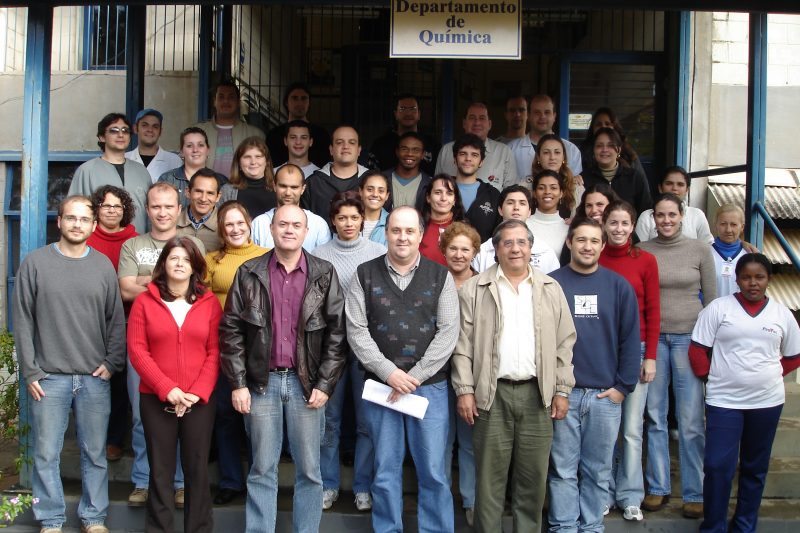
Featured scientist: interview with Carlos Graeff.
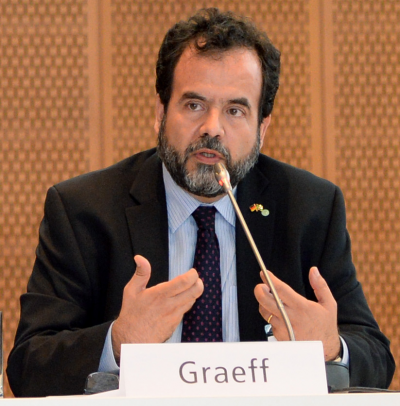
Fascinated by science since he was a child, with a representative at his home (his father, a renowned neuroscientist), Carlos Frederico Oliveira Graeff, born at Ribeirao Preto (state of São Paulo), chose the area of Physics as his university studies. He obtained his bachelor’s (1989), master (1991) and doctor (1994) degrees in Physics from the University of Campinas (Unicamp). During his master’s and doctorate program, supervised by professor Ivan Chambouleyron, he took his first steps as a researcher in the Materials area with studies on materials based on germanium and silicon. During his doctorate he participated in a research internship at the Max Plank Institut für Festkörperforschung in Germany.
He returned to Germany in 1994 until 1996 for a postdoctoral period to work on electronic magnetic resonance, semiconductors and electronic devices at the Walter Schottky Institute of the Technische Universität München (TUM), with a grant from the German foundation Alexander Von Humboldt.
Upon returning to Brazil, he became a professor at the Department of Physics and Mathematics of the University of São Paulo (USP), where he remained for 10 years. In 2006, he joined the Faculty of Sciences of Bauru at the State University of São Paulo (UNESP) as a full professor, where he is still teaching and researching. Throughout his academic career, Graeff has been visiting professor or researcher at several institutions in France, China and Switzerland.
From 2007 to 2009, Graeff was coordinator of the Post-Graduate Program in Materials Science and Technology (POSMAT) at UNESP – Bauru campus. Between 2009 and 2014, he was the coordinator of the newly created Materials Area of CAPES, responsible for the evaluation of Brazilian post-graduate programs in Materials, among other functions. From 2011 to 2013, Graeff was president of the Humboldt Club of Brazil and in 2012 and 2013 he was scientific director of B-MRS. The scientist also fulfilled or performs management or advisory functions at Brazilian agencies FAPESP and CAPES, and at IUPAC (International Union of Pure and Applied Chemistry).
In 2017, after having participated in the editorial board of several international journals, he was appointed associate editor in the photovoltaic area of the journal Solar Energy (impact factor 4,018), of Elsevier publishing house. Also in 2017, he became Dean of Research at UNESP, a post he holds until now.
With an h index of 28, Graeff is the author of about 200 indexed papers that have more than 2,500 citations, according to Google Scholar. In three decades of scientific work, together with his team at the Laboratory of New Materials and Devices at UNESP and his numerous national and international collaborators, Graeff has contributed to the field of materials research with multiple subjects. Among his most cited articles there are studies on synthetic diamond, silicon and germanium heterostructures, conjugated polymers, latex and melanin (biological material with semiconductor properties that are promising for the development of bioelectronic devices).
The researcher has also worked in the area of photovoltaic energy (direct conversion of solar radiation into electricity), with numerous contributions to the development of solar cells based on different materials (dyes, perovskites and organic semiconductors). On this subject of photovoltaic energy, Carlos Graeff will offer a plenary lecture at the XVII B-MRS Meeting, to be held in Natal (RN) from September 16 to 20.
The following is an interview with this outstanding researcher of our community.
B-MRS Newsletter: How or why did you become a scientist? Did you always want to be a scientist? Also, briefly tell us what led you to work in the field of materials.
Carlos Graeff: My father, Frederico Graeff, is a well-known researcher and perhaps one of the most important influences in my decision. My aunts were also teachers and researchers, so from an early age I had access to the world of science from my home, which has always fascinated me. The decision to study physics was largely due to the various books I read and from the television Cosmos series presented by Carl Sagan. The decision to work in the Materials area came later on during my baccalaureate in physics after the first courses in condensed matter physics and semiconductors. From the beginning of the graduate studies I worked in materials, and soon I was attracted by the interfaces of physics with chemistry and biology in very different subjects of materials science and engineering.
B-MRS Newsletter: What do you believe are your main contributions to the Materials area? Please consider all aspects of scientific activity.
Carlos Graeff: It is always difficult to choose key contributions. In my case in particular it is easy to see, reading my CV, a very eclectic trajectory in terms of studied materials and applications. Using originality as a preference, I will dwell on three themes; the first is the production of CoS (cobalt sulfide) the basis of ecological paints for the production of electrodes for solar cells. We have achieved a simple, industrial and ecological method to replace platinum in dye-based solar cells. In the second theme, we have proposed several alternative methods for the synthesis of melanin, the material involved in tanning, and with this we have been able to produce biocompatible materials with very special characteristics with regard to, for example, solubility. We are identifying a very important defect for this material using, as a main tool, computational simulations combined with spectroscopic techniques. We are sure this material will be important in the emerging area of bioelectronics. In the third theme, we describe in detail the whole degradation process of organic semiconductors, identifying routes for the production of high sensitivity dosimeters for applications in hospitals and clinics that use, for example, gamma rays for cancer treatments and diagnosis. We also have had very unique contributions in the physics of electrically detected magnetic resonance, increasing the sensitivity and the general understanding of the physical phenomena involved. In addition to these fundamental contributions, I was responsible, proudly and with satisfaction, for the implementation of the materials area at CAPES. Another source of satisfaction regards the good students I was fortunate enough to mentor, many of them brilliant scientists. I helped and coordinated the assemblage of several laboratories both here in Brazil and abroad, most recently I helped set up a magnetic resonance laboratory in China.
B-MRS Newsletter: Now we invite you to leave a message for our readers who are starting their scientific careers.
Carlos Graeff: I started my master’s degree in 1989, a time that was perhaps as troubled as the current one, do not get discouraged! With focus and a bit of luck it is always possible to create new ideas, build a solid career and contribute to our beautiful country. We are going through a great revolution, with the emergence of new technologies that will profoundly transform society. Intelligence will increasingly play a decisive role in the direction of our society, be prepared to work in this new world of great opportunities. Always seek out dialogue with specialists from the most different areas of knowledge and from various countries. Quite possibly, in the coming years we will unravel the mysteries of how the brain works, we will master limitless forms of energy and ecological production, generate artificial intelligence. Open up to what is new, be bold, Brazil needs your citizen and entrepreneurial spirit.
B-MRS Newsletter: You will deliver a plenary lecture at the XVII B-MRS Meeting. Leave an invitation to our community.
Carlos Graeff: Photovoltaic energy is reaching its commercial maturity, we are living an unprecedented energy revolution. In the lecture I will show some updated data on the perspectives of using photovoltaic cells in Brazil and in the world; its principles of operation; the challenges for scientists and material engineers in this relentless race for increasingly efficient, durable and environmentally friendly materials, processes and devices. I will present our group’s latest results on this topic.
Featured paper: Polystyrene, from pollutant to environmental remediator.
[Paper: Conversion of “Waste Plastic” into Photocatalytic Nanofoams for Environmental Remediation. Geovania C. de Assis, Euzébio Skovroinski, Valderi D. Leite, Marcelo O. Rodrigues, André Galembeck, Mary C.F. Alves, Julian Eastoe, and Rodrigo J. de Oliveira. ACS Appl. Mater. Interfaces, 2018, 10 (9), pp 8077–8085. DOI: 10.1021/acsami.7b19834].
Polystyrene, from pollutant to environmental remediator
A team composed of seven researchers from Brazil and one from the United Kingdom used polystyrene waste, which is a potential environmental polluter, to produce a material that works as an environmental remediator by degrading toxic compounds in water bodies and waterways. Therefore, the research makes a contribution to two disturbing environmental problems: on the one hand, the presence of large amounts of plastic waste on the planet; on the other hand, pollution or contamination with toxic substances in aquatic ecosystems.
The research was reported in a paper recently published in the journal Applied Materials & Interfaces (impact factor = 7,504).
We know that polystyrene is used to make disposable cups and cutlery, yogurt pots, combs, hangers, organizer boxes and many other utilities, in addition to being the main component of the well-known isopor®. “We present an alternative to reuse one of society’s most demanded plastics,” says Professor Rodrigo José de Oliveira, from Paraíba State University (UEPB), corresponding author of the paper.

The material developed by the scientific team consists of a porous polymer matrix impregnated with nanoparticles of tin dioxide (SnO2). In this composite material, while the nanoparticles are largely responsible for degrading the toxic compounds (dyes) by a photocatalytic process, the polymer matrix, which is produced from polystyrene waste, creates an environment favorable to photocatalytic activity and supports the nanoparticles, allowing them to be easily removed from the waters, and reused in new processes of environmental remediation.
The authors of the article called the new composite material “nanofoam”. Although they have a few centimeters in diameter and pores of a few micrometers, the foams have received the prefix “nano” because their photocatalytic properties are due to the presence of nanometric-sized tin dioxide (spherical nanoparticles of about 20 nm). “Nanomaterials are those that present new properties due to a distinct physics that appears in this size scale,” recalls Oliveira.
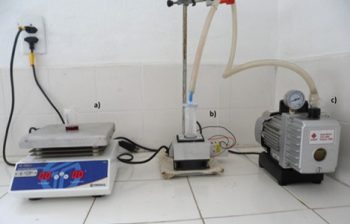
To obtain composite foams, the team used low cost equipment and procedures based on well-known physicochemical properties. The preparation process is described in broad lines as follows. First, small pieces of polystyrene waste are dissolved in cyclohexane solvent, and the tin dioxide nanoparticles, which here were manufactured by the team, are added to the solution. This part of the process is carried out above the so-called “theta temperature (θ)” of the cyclohexane and polystyrene solution, which is about 36 °C, because below this temperature the solution undergoes a phase separation. Second, the preparation is carried out for 10 minutes at a temperature of 10 °C. As a consequence of this temperature decrease, some phenomena take place. The solution separates into two phases, one rich in polystyrene and the other rich in cyclohexane, and the solvent freezes. At the end of the cooling process, the phases are distributed in such a way that they form a polystyrene structure with holes filled with frozen cyclohexane. In order to remove the solvent from the foams, a lyophilization process is applied, whereby the cyclohexane undergoes sublimation. As a final result, a porous solid is obtained that the authors of the article called nanofoam.
“We have shown that a dense polystyrene waste can be readily converted into a porous polymer matrix, which is desirable for making new materials, that is, a noble end to pollution that has mobilized governments from industrialized countries,” says Professor Oliveira.
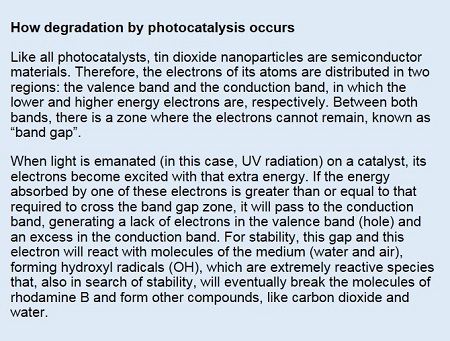 Finally, the scientific team evaluated the efficiency of the new material as an environmental remediator by testing the ability of nanofoams to degrade a magenta-like dye called rhodamine B. This compound, which is used as a marker in health, research, agriculture areas, is toxic to the reproductive and neurological system, and in some studies it has been pointed out as a carcinogenic agent.
Finally, the scientific team evaluated the efficiency of the new material as an environmental remediator by testing the ability of nanofoams to degrade a magenta-like dye called rhodamine B. This compound, which is used as a marker in health, research, agriculture areas, is toxic to the reproductive and neurological system, and in some studies it has been pointed out as a carcinogenic agent.
The nanofoams of Professor Oliveira and his collaborators managed to degrade 98.2% of rhodamine B – a result superior to those obtained with photocatalytic nanoparticles outside the polystyrene matrix. In addition, the nanofoams demonstrated very good performance when reused: they degraded more than 96% of rhodamine B in the first four cycles. “It is desirable to use a matrix because it facilitates the final recovery of the photocatalyst, since the foam is easily removed from the medium using steel tweezers, in addition to an increase in the surface area due to higher oxide dispersion in the matrix,” says Oliveira.
History of the work
Rodrigo de Oliveira was involved in his doctorate when, in 2011, he had the idea of obtaining new catalytic materials, taking advantage of the characteristic of some solutions in which their phases are separated by the effect of temperature (known as “thermally induced phase separation,” TIPS). Oliveira was in an internship abroad (the so-called “doctoral sandwich”) in the group of Professor Julian Eastoe at the University of Bristol. In this group, Oliveira had found the double possibility of working with surfactants, the subject of his doctoral research, and also improving his command of the English language. “In Bristol, Julian presented me with a paper he had published decades ago on the use of TIPS to study microemulsions and the formation of calcium carbonate foams,” Oliveira recalls. By the end of the internship, the Ph.D. work had developed a surfactant foam decorated with gold nanoparticles. In England, in addition to this work in Bristol, Oliveira made contact with a renowned group at Cardiff University dedicated to catalysis research, led by Professor Graham Hutchings. “The possibility of obtaining new catalytic materials using TIPS was cogitated,” recalls Oliveira.
In 2012, Oliveira obtained a doctor’s degree in Chemistry from the Federal University of Pernambuco (UFPE). Shortly after, after qualifying in the selection process of UEPB, he became a professor of that institution. The young researcher then saw the opportunity to realize the idea he had envisaged in England. In order to carry it out, he had to venture into a new research line, different from what he had pursued during his undergraduate, master’s and doctoral works, but he was already experienced with this. In fact, during his undergraduate, master’s and doctorate courses in Chemistry, all of them at UFPE under the guidance of Professor André Galembeck, he had addressed three very different research topics. “André has always been open to proposals and ideas, including those that differed from the group’s research history,” declares Oliveira.
There was no lack of courage, but Oliveira had just arrived at UEPB and had no infrastructure available, nor the financial resources to build it. “From 2012 to now, our struggle has been to establish a research group in physical chemistry of materials, and one of the focused lines is the use of TIPS to make materials from plastic waste,” he says. In the case of nanofoams, the researcher was able to develop the work within Geovânia Cordeiro de Assis’s master’s thesis, defended in 2016 and supervised by Oliveira together with professor Mary Cristina Ferreira Alves (co-supervisor). For the preparation of the nanofoams, the team used simple and inexpensive equipment (“a $ 20 refrigeration plate purchased from China’s import website and a vacuum pump”). For the characterizations, which necessarily require more expensive equipment, Oliveira had the collaboration of colleagues from UFPE, University of Brasilia and University of Bristol.
Other materials with environmental applications will be generated in the city of Campina Grande, in the laboratory of Professor Oliveira, using various types of plastics, including those with a more complex composition such as styrofoam®, which is composed of expanded polystyrene and other chemical components. In addition to developing materials to contribute to the remediation of ecosystems, the group is using them for more fundamental studies, which could generate nanomaterials with sophisticated structures.
“Unfortunately, we are constantly faced with the lack of characterization equipment, and nowadays neither the collaborators with the best of intentions have the resources to help us as before,” Oliveira laments. “I realize there are quality human resources in our institution; however, more investments in infrastructure are fundamental to maintain the quality of the work, training of human resources and internalization of state of art science,” he adds.

Founding President of B-MRS is elected Fellow of the Microscopy Society of America (MSA).
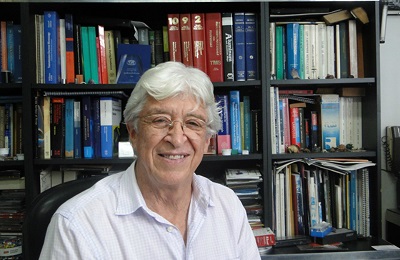
Professor Guillermo Solórzano-Naranjo, one of the leaders in the creation of B-MRS and the first president of the society, was appointed fellow of the Microscopy Society of America (MSA) at the end of February of this year. Thus, Solórzano-Naranjo became the first academic in Latin America with a MSA fellowship status.
This title is intended for senior members of that scientific society who have contributed significantly to the advancement of microscopy and microanalysis. In the case of Professor Solórzano-Naranjo, he was chosen for his excellence in the application of microscopy to solve materials problems, as well as for the service rendered as ambassador for international cooperation through microscopy.
Guillermo Solórzano-Naranjo is a professor in the Department of Chemistry and Materials Engineering at PUC-Rio. He is a member of the board of the International Federation of Societies for Microscopy (IFSM), where he is also the only representative of Latin America. In addition to being founding president of B-MRS, he has served or was a member of executive committees of several scientific entities in the field of microscopy, such as the Brazilian Society of Microscopy and Microanalysis (SBMM), the Brazilian Society of Electronic Microscopy (SBME); Inter American Committee of Societies for Electron Microscopy (IACSEM); International Union of Microbeam Analysis Society (IUMAS). He was also chairman of the seventeenth edition of the International Conference of Microscopy, held in 2010 for the first time in South America.
Solorzano-Naranjo will be honored by MSA at the awards ceremony that will take place at the opening of the M&M2018 event on August 6 in Baltimore (United States).
XVII B-MRS Meeting: abstract submission is open.
|
||||||||||||||||
|
B-MRS Newsletter. Year 5, issue 2.
|
|||||||||||||||||||||||||||||
|
|||||||||||||||||||||||||||||
|
Featured paper: Moving nanoparticles for asymmetric nanowires.
[Exploring Au Droplet Motion in Nanowire Growth: A Simple Route toward Asymmetric GaP Morphologies. Bruno C. da Silva*, Douglas S. Oliveira, Fernando Iikawa, Odilon D. D. Couto Jr., Jefferson Bettini, Luiz F. Zagonel, and Mônica A. Cotta*. Nano Lett., 2017, 17 (12), pp 7274–7282. DOI: 10.1021/acs.nanolett.7b02770]
Moving nanoparticles for asymmetric nanowires.
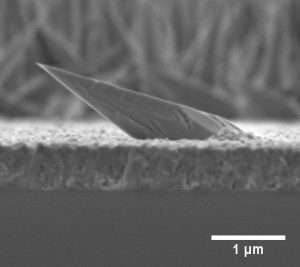
A team of scientists presented a route to grow semiconductor nanowires having an asymmetric morphology, different from the traditional cylindrical one. The possibility of producing, in a controlled manner, nanowires with particular formats and without defects, can be exploited in several applications, including the production of more efficient solar cells.
The research was led by scientists from the Brazilian university UNICAMP and the Brazilian Nanotechnology National Laboratory (LNNANO), who reported their findings in a paper in NanoLetters.
The researchers discovered the process while studying the production of nanowires of gallium phosphide (GaP) for optoelectronic applications. The team chose to produce the nanowires by chemical beam epitaxy (CBE), preceded by a thermal treatment (annealing). In this technique, a substrate of a suitable material – in this case gallium arsenide (GaAs) – is placed inside a chamber. Then, chemical compounds in the form of vapor are introduced into the chamber. Some elements of the vapored material deposit over the substrate, layer upon layer, generating films. To promote the growth of nanowires instead of films, metallic nanoparticles (in this case, gold nanoparticles) are placed on the substrate before being exposed to vapor. During exposure, these catalytic nanoparticles cause the material to deposit preferentially underneath them, causing wire-like structures to grow.
While the researchers were analyzing the nanowires they had obtained in the first few months of the work, they found a significant amount of asymmetric nanostructures. “Besides having a particular morphology, we saw that these nanowires had an hexagonal crystal structure (wurtzite) and a very low density of crystallographic defects, which motivated us to study in detail the causes for the formation of this unusual structure,” says Bruno da Silva, PhD student at UNICAMP and corresponding author of the paper.
Da Silva and his supervisor Prof. Mônica Cotta then began to raise and test hypotheses for the cause behind the formation of the peculiar structures. After several experiments and analyses, they focused on a phenomenon that caught their attention: in the early stages of the process, the gold nanoparticles spontaneously moved over the substrate. Hence, the duo undertook a systematic work on heating substrates with nanoparticle catalysts, growing nanowires under various conditions, and analyzing the resulting samples through scanning and transmission electron microscopes and atomic force microscopy.
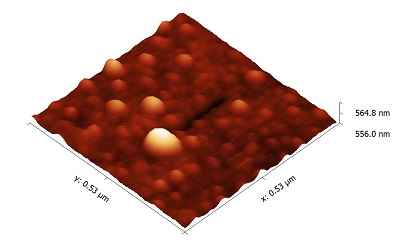
Da Silva, Prof. Cotta and their collaborators from UNICAMP and LNNano were able to find out why the growth process they used resulted in asymmetric nanowires. The main reason was the movement of the gold nanoparticles, which was thermally activated with the initial annealing. Based on that discovery, the team established a recipe for producing asymmetric semiconductor nanowires in a controlled manner. “Our work was the first to show that the mechanical instability of the nanoparticle catalyst can be used to modify the growth of semiconductor nanowires, in our case, particularly affecting their morphology,” says Bruno da Silva.
The mechanism of the asymmetric nanowires growth presented in the NanoLetters paper can be described as follow. When heated together with the substrate, the nanoparticles begin to crawl and advance through the substrate while consuming the oxide layer that naturally covers the gallium arsenide. Thus, the nanoparticles form asymmetric grooves a few nanometers deep and a few hundred nanometers long. These trails become fertile ground for the growth of the nanowires, since the deposition rate of the vapored material is greater there than in the rest of the substrate, which is covered by the oxide. A pedestal then forms along the grooves and the nanowire grows on top of the pedestal with an asymmetrical format. “We showed that the movement of the particle generates a zone of preferential deposition, and that the combination of this phenomenon with the axial growth “vapor – liquid – solid” leads to the asymmetry in the nanowire,” summarizes da Silva.
Besides describing the formation mechanism of asymmetric nanowires, the work of the Brazilian team generated detailed knowledge about the movement of heated metallic nanoparticles. “We have shown that in addition to temperature, vacuum conditions and surface quality of the substrate are crucial for nanoparticle stability, and that the motion direction is related to the asymmetry of gold dissolution on semiconductor surfaces III-V,” details the doctorate student.
Concerning possible applications, the asymmetry of these nanowires can be explored, for example, in the construction of antireflective layers that reduce the amount of light lost by reflection in solar cells. Another possibility would be to exploit the green emission of these wurtzite gallium phosphide nanowire in lighting devices. Or, why not, to develop an alternative process to electronic litography taking advantage of the gold nanoparticles movement and the trails it forms on the substrate.
The work was funded by Unicamp, the Brazilian federal agencies CNPq and CAPES and the São Paulo Research Foundation (FAPESP).
